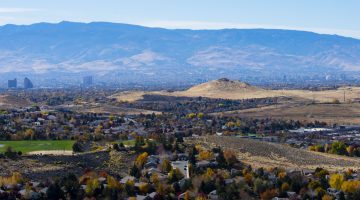By Ryan McGinnis
Half a million years ago, man harnessed fire. A thousand years ago, man spun flaming balls made of plant fibers and fabric, attached to a twisted flax-leaf cord. Today, a group of twenty-odd University of Nevada, Reno students replace the plant fibers with Kevlar material and fabric with white gas camp fuel.
Following the same ancient technique developed by the Maori tribe of New Zealand—the art of poi—they spin fire.
The Maori tribe originally used poi to increase wrist dexterity and strength for battle. As residents of the Western Hemisphere immigrated to New Zealand, the sport spread and became popular in small pockets around the world.
In the United States, it found a home in counter-culture movements, specifically among attendees of the annual Burning Man festival.
According to UNR student Sloan Currie, the eccentricity of burner culture and the potential dangers of fire spinning have kept the sport underground, almost taboo.
“[The burners] taught me the geometry of fire-spinning, how the poi moves across different planes,” Currie said. “Because if you don’t know what you’re doing you can kill yourself.”
Currie was tantalized by how the spinners could effortlessly do such a dangerous task without worry. Looking to find a fire-troop (what spinners call their performance groups) on campus, Currie soon discovered the UNR Cirque Club, formerly known as the UNR Fire Spinning Club.
For club president Brianne Isa, UNR Cirque, which meets every Friday on the third floor of the DeLeMare Library from 5p.m. to 7p.m., is an opportunity to discover and foster a bevy of off-kilter talents.
In an effort to attract a wider array of performers, the organization, opened its doors to include juggling, yo-yoing, hula-hooping, aerial performances and other object manipulation activities.
While many of these activities have a steep learning curve, the club is open to people of all levels of experience. According to UNR Cirque member Brandon Burke, despite the difficulties, it’s well worth the experience.
“When you first start out, you’ll get a lot of bruises, practicing poi in particular,” Burke said. “But in the end it builds character.”
Before joining the club, Currie learned a majority of his spinning technique through a close friend and online tutorials. The UNR Cirque club helped introduce him to others who share the same passion he has for the sport.
“It’s an individual sport in the presence of others,” Currie said. “Every time you spin with others you can see if their technique is wrong or right—and you might learn something.”
Weather permitting, the UNR Cirque Club often practices in the Manzanita bowl, using trees as anchors for aerial acrobats and the open space for traditional poi training. The university, however, doesn’t allow the club to fire spin on campus without necessary permits.
But that doesn’t stop them from performing in their own backyards, where most of the fire spinning practice takes place. Experienced members help guide new members through the art of spinning fire; they help prepare the poi to be lit and keep the spinner in a safe environment, while flaming balls of fabric move in every direction.
While small, the club is looking to become more involved in the community and is exploring the possibility of performing during next month’s Relay for Life event at Mackey Stadium.
“It’s surreal, once you get the technique down it’s almost therapeutic to a have fire spinning around you in an artful way,” Currie said.
Ryan McGinnis can be reached at thersko@ sagebrush.unr.edu.













